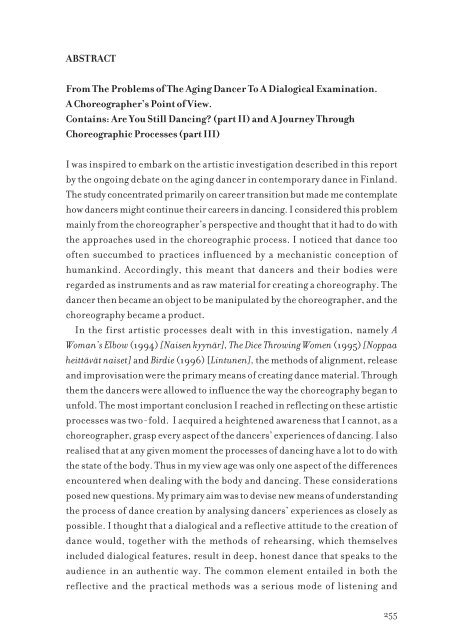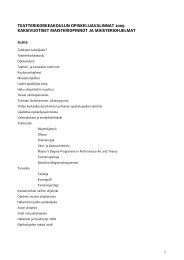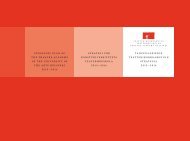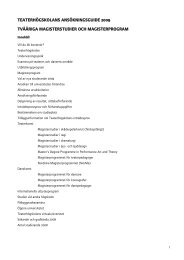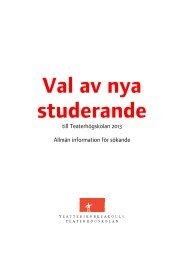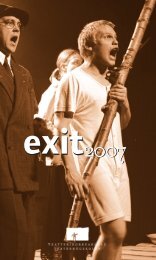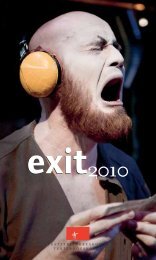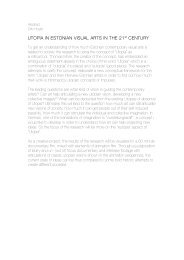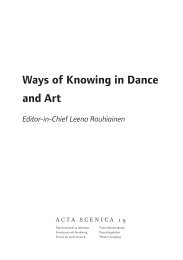- Page 1 and 2:
Vanhenevan tanssijan problematiikas
- Page 3 and 4:
Riitta Pasanen-Willberg Vanhenevan
- Page 6 and 7:
Sisällys Esipuhe 11 Pohdintojani 1
- Page 8 and 9:
Lispetti 102 Porri alla sienen 103
- Page 10 and 11:
Valinta 195 Keskusteluja Jaana Klev
- Page 12 and 13:
Esipuhe Aika taaksepäin katsottuna
- Page 14 and 15:
Pohdintojani Seuraavassa ajatuksian
- Page 16:
I OSA Taiteellisen työn taustat ja
- Page 19 and 20:
vien kohdallisten käsitteiden löy
- Page 21 and 22:
Taiteellisen työn merkitykset eiv
- Page 23 and 24:
Otteeni oman taiteellisen työn tar
- Page 25 and 26:
Ensimmäisen osan yhteydessä olen
- Page 27 and 28:
kertaa vasta ensimmäisen esityksen
- Page 29 and 30:
Uuttako tanssia? 28 It is important
- Page 31 and 32:
lesta ja luonnon elementeistä, tre
- Page 33 and 34:
aatteensa perustuivat pitkälti Haw
- Page 35 and 36:
tilaisuudessa kävi ilmi, että mar
- Page 37 and 38:
Tähän sisältyy paradoksi: vaikka
- Page 39 and 40:
nen ei ole kuitenkaan kone, joten t
- Page 41 and 42:
akennuselementtinä tai improvisaat
- Page 43 and 44:
grafi asiantuntija, tarkan mallin a
- Page 45 and 46:
lisäksi haastattelin Liisa Pentti
- Page 47 and 48:
Naisen Kyynär 1994. Kuvassa Riitta
- Page 49 and 50:
48 Onko absoluuttista tilaa olemass
- Page 51 and 52:
2. Vanheneva tanssija koreografin n
- Page 53 and 54:
sijan omat intentiot ilmenevät par
- Page 55 and 56:
-venyvyys vähenevät iän myötä.
- Page 57 and 58:
Ongelmavyyhti on hienovarainen ja s
- Page 59 and 60:
Ratkaisu, jossa tanssijat jaotellaa
- Page 61 and 62:
3. Tanssiteos Naisen kyynär (1994)
- Page 63 and 64:
62 On tärkeä tunnistaa itsensä j
- Page 65 and 66:
Harjoituksissa keskityttiin aluksi
- Page 67 and 68:
taa myös hyvin tarkan liikkeen yhd
- Page 69 and 70:
Kun lapsi syntyy, on hänellä viel
- Page 71 and 72:
70 sija. Ruveta aistimaan itsensä
- Page 73 and 74:
vastata itselleni kysymykseen miksi
- Page 75 and 76:
74 Kiitokset monet tanssinäytökse
- Page 77 and 78:
76 Noppaa heittävät naiset 1995.
- Page 79 and 80:
78 KUKONASKEL, SASSÉ-hyppysarja si
- Page 81 and 82:
80 lut varmistuivat vain viikoksi k
- Page 83 and 84:
Liikkeellisesti tanssijat eivät eh
- Page 85 and 86:
Lintunen 1996. Kuvassa Liisa Pentti
- Page 87 and 88:
Valkoinen lintu - matka kotkasta ku
- Page 89 and 90:
88 -Mä on niin piilossa, mies-kult
- Page 91 and 92:
90 mahdotonta ennen kuin Vainio on
- Page 93 and 94:
92 Tämä uusi metodi mahdollistaa
- Page 95 and 96:
Mielikuvat ja videot muistiinpanoin
- Page 97 and 98:
96 vartalon etupuolelta ja päätyy
- Page 99 and 100:
yhdistävänä tekijänä. Miten t
- Page 101 and 102:
sästi ja kiusoittelevasti, kontakt
- Page 103 and 104:
102 ...ja sitten se, että me panti
- Page 105 and 106:
Koreografisen näkemykseni mukaan e
- Page 107 and 108:
106 Lintunen - se oli tanssi vapaud
- Page 109 and 110:
108 irtonaisemmin ja kokonaisemmin
- Page 111 and 112:
6. Yhteenvetoja - Lintunen-trilogia
- Page 113 and 114:
Kokemuksen luonne Prosessista saatu
- Page 115 and 116:
Mielestäni kysymys on itsensä lö
- Page 117 and 118:
tanssijaan ovat hitaita. Toisin san
- Page 120 and 121:
III OSA Matka kyynärästä jokeen
- Page 122 and 123:
1. Matka kyynärästä jokeen You a
- Page 124 and 125:
liikkumisesta ollen silti omalla hi
- Page 126 and 127:
Kahdeksan jokea 1997. Kuvassa Raisa
- Page 128 and 129:
Kokemuksen luonne Arkikielessä kok
- Page 130 and 131:
Näiden ongelmalliseksi kokemieni t
- Page 132 and 133:
pyrkinyt löytämään perusteita s
- Page 134 and 135:
muoto. Rajanveto on vaikeaa. Jorma
- Page 136 and 137:
ilmiöiden tarkastelun yhteydessä,
- Page 138 and 139:
Dialogisuus tarkoittaa sitä, että
- Page 140 and 141:
itse liikemateriaali ollut ensisija
- Page 142 and 143:
hän koreografian puitteissa saisi
- Page 144 and 145:
metodin mukaiseen työskentelyyn, 2
- Page 146 and 147:
että liikkeen luonnollinen virta e
- Page 148 and 149:
tuovat esille kokemuksiaan niistä.
- Page 150 and 151:
Kahdeksan jokea sarjan mieletön yh
- Page 152 and 153:
ulotteinen olotila. Olotila, jossa
- Page 154 and 155:
Kahdeksan jokea 1997. Kuvassa Pia K
- Page 156 and 157:
Ajatus soveltuu hyvin kuvaamaan tan
- Page 158 and 159:
sa hekin, kilpikonnien trio, lopult
- Page 160 and 161:
sarjat tarkkaan järjestykseen suor
- Page 162 and 163:
Kvartetti. Kahdeksan jokea 1997. Ku
- Page 164 and 165:
Valssia on elämä tää... (ja mak
- Page 166 and 167:
istiriitaiseksi sen, että hänen s
- Page 168 and 169:
Valssia on elämä tää... (ja mak
- Page 170 and 171:
alun lyhyt sooloesitys tuntuikin va
- Page 172 and 173:
5. Dialogisuus ja miten se ilmenee
- Page 174 and 175:
mi koki tekevänsä ei-mitään. Lo
- Page 176 and 177:
Heuristiset vaiheet tiivistettynä
- Page 178 and 179:
6. Hevoslauluja Horse Songs - rakka
- Page 180 and 181:
kun se siirtyy unesta tapahtumiseen
- Page 182 and 183:
Kädet tavoittelevat otteeseen, jal
- Page 184 and 185:
keskeyttämään tehdäkseen lopull
- Page 186 and 187:
Harjoitusprosessi oli pitkä, nelj
- Page 188 and 189:
Hiljaisuuksia 1999. Kuvassa Jaana K
- Page 190 and 191:
vään 1992 aikana valmistimme yhte
- Page 192 and 193:
kuvaa omaa senhetkistä tilaansa ja
- Page 194 and 195:
Pohdimme vanhenevan tanssijan probl
- Page 196 and 197:
Soolovuorottelussa kumpikin havainn
- Page 198 and 199:
siinä, vaikka mä istuinkin koreog
- Page 200 and 201:
Riitta/lähestymisero: Siinä oli s
- Page 202 and 203:
Jaana/olla katsottavana: Tai silloi
- Page 204 and 205:
Jaana: Mutta onhan se meille kaivo
- Page 206: Hiljaisuuksia 1999. Kuvassa Jaana K
- Page 210 and 211: 1. Mitä olen löytänyt? Näissä
- Page 212 and 213: erilaisiin kasvu- ja kehityskontrol
- Page 214 and 215: intention idea voimakas. Sen myöt
- Page 216 and 217: Usein vanhemmat tanssijat suhtautuv
- Page 218 and 219: avulla välitetään. Onko koreogra
- Page 220 and 221: emmin, mikä on tanssia ja mitkä o
- Page 222 and 223: to, joka vaikuttaa kaikkeen siihen,
- Page 224 and 225: Transformational Dance. Wesleyan Un
- Page 226 and 227: saan. Helsingin Sanomat, kulttuuris
- Page 228 and 229: Vähäkallio, Katariina. Palaute te
- Page 230 and 231: Liite Liite Liite 1 1 Teosluettelo:
- Page 232 and 233: Passport, please, ensi-ilta 6.4.199
- Page 234 and 235: Liite Liite 2 2 Lehtiarvosteluja te
- Page 236 and 237: Riitta Pasanen on itse hyvin taitav
- Page 238 and 239: yhdessä Gripenbergin kanssa. Tanss
- Page 240 and 241: maailma on rikkaampaa ja ennen kaik
- Page 242 and 243: Arvostelut teoksista Horse Songs (1
- Page 244 and 245: 2.12. Tarja Tikkanen 3.8.1998, Iisa
- Page 246 and 247: 2.14. Jan-Peter Kaiku 29.5.1999, Hu
- Page 248 and 249: kittynyt opetustyöhön, kirkkotans
- Page 250 and 251: koulussa 1993. Hänen Teatterikorke
- Page 252 and 253: Klevering on työskennellyt tiiviis
- Page 254 and 255: TIIVISTELMÄ Vanhenevan tanssijan p
- Page 258: Riitta Pasanen-Willberg on 1980-luv


